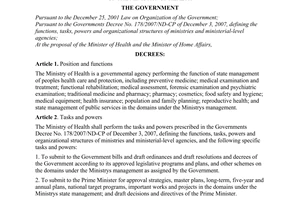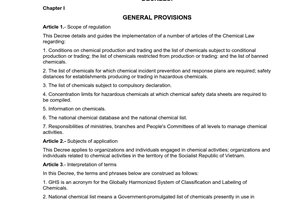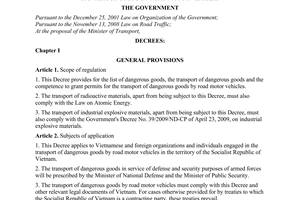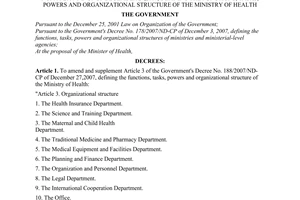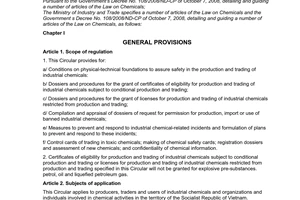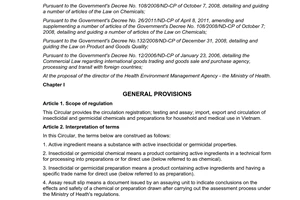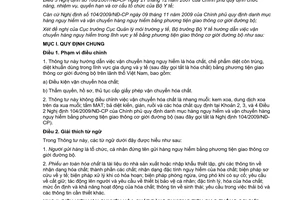Nội dung toàn văn Circular No. 08/2012/TT-BYT guiding the transport of dangerous goods in the heal
|
THE MINISTRY
OF PUBLIC HEALTH |
SOCIALIST REPUBLIC OF VIETNAM |
|
No. 08/2012/TT-BYT |
Hanoi, May 17, 2012 |
CIRCULAR
GUIDING THE TRANSPORT OF DANGEROUS GOODS IN THE HEALTH SECTOR BY ROAD MOTOR VEHICLES
Pursuant to the Law on Road Traffic, of November 13, 2008;
Pursuant to the Government's Decree No.188/2007/ND-CP of December 27, 2007, defining the functions, tasks, powers and organizational structure of the Ministry of Public Health;
Pursuant to the Government's Decree No. 22/2010/ND-CP of March 9, 2010, amending and supplementing Article 3 of the Government's Decree No.188/2007/ND-CP of December 27, 2007, defining the functions, tasks, powers and organizational structure of the Ministry of Public Health;
Pursuant to the Government's Decree No.104/2009/ND-CP of November 9, 2009, providing the list of dangerous goods and the transport of dangerous goods by road motor vehicles;
At the proposal of the director of the Health Environment Management Administration, the Minister of Public Health guides the transport of dangerous goods in the health sector by road motor vehicles as follows:
Section I GENERAL PROVISIONS
Article 1. Scope of adjustment
1. This Circular guides the transport of dangerous goods being chemicals, insecticidal preparations and germicidal preparations used in domestic and medical field (hereinafter referred to as chemicals) by road motor vehicles in the territory of Vietnam, including:
a/ Conditions of transport of chemicals;
b/ Competence, dossiers of and procedures for licensing transport of chemicals.
2. This Circular does not adjust the transport of chemicals being mosquito repellent coils; mosquito repellent creams or lotion; mosquito repellent mats; baits to kill ant, cockroach and fly; and the chemicals specified in Clauses 2, 3 and 4, Article 2 of the Government's Decree No. 104/ 2009/ND-CP providing the list of dangerous goods and the transport of dangerous goods by road motor vehicles (hereinafter referred to as the Decree No. 104/ 2009/ND-CP).
Article 2. Interpretation of terms
In this Circular, the terms below are construed as follows:
1. Consignor is an organization or an individual that consigns dangerous goods under name of such organization or individual by road motor vehicles.
2. Chemical safety data sheet is a document made by a manufacturer or an importer, indicating information on chemical identification; substance composition; identification of dangerous properties of the chemical; medical first aid measures; fire-fighting measures; prevention and response measures when having incident; storage requirements; impacts on human and requirements on personal protection equipment; physical and chemical properties of the chemical; stability and reactivity of the chemical; ecological information; requirements on elimination and other necessary information.
Section II: CONDITIONS FOR TRANSPORT OF CHEMICALS BY ROAD MOTOR VEHICLES
Article 3. Principles of transport of chemicals
1. Transport of chemicals must comply with the Decree No.104/2009/ND-CP law on road and railway traffic order and safety and other relevant laws.
2. Chemicals may be transported only after being packed and labeled as prescribed in this Circular.
3. When transporting chemicals of from one thousand kilograms (1,000 kg) /vehicle/time or more, agencies, organizations or individuals (hereinafter referred to as the carriers) must possess a transport of chemicals permit.
4. When transporting chemicals of less than 1,000 kg/vehicle/time, the carriers are not required to possess a transport of chemicals permit but must comply with provisions in Section II of this Circular.
5. Trailers are not permitted to be used for transport of chemicals.
6. Chemicals that can react with one another are not permitted to be transported in a same vehicle.
7. Chemicals are not permitted to be transported together with passengers, livestock, food, inflammable and explosive substances and other goods.
Article 4. Requirements on packaging, tanks or containers in the course of transportation
1. To be made of appropriate materials for each chemical type as prescribed in Article 25 of the Circular No. 29/2011/TT-BYT of June 30, 2011, of the Public Health Ministry providing on management of chemicals and insecticidal and germicidal preparations used in domestic and medical field;
2. To be labeled with an icon showing physical properties of the chemical under the Form No.1 of Annex 1 enclosed with this Circular. The size of this icon is 100 mm x 100 mm for every chemical containing tank and 250 mm x 250 mm for container.
3. To be labeled with a symbol of dangerous goods under the Form No. 2 of Annex 1 enclosed with this Circular. The size of this symbol is 100 mm x 100 mm for every chemical containing tank and 250 mm x 250 mm for container.
4. To have a dangerous warning sign under the Form No.3 of Annex 1 enclosed with this Circular. The size of this sign is 300 mm x 500 mm.
Article 5. Requirements on transport vehicles
In addition to the requirements specified in Article 13 of the Decree No.104/2009/ND-CP a vehicle transporting chemicals must satisfy the following provisions:
1. When transporting, it has appliances and equipment for fire prevention and fighting that are suitable to chemicals.
2. It has hood or canvas that may fully and tightly cover the cargo compartment to ensure no water permeation during transport.
3. The size of the symbol of dangerous goods stuck on the vehicle is 500 mm x 500 mm.
Article 6. Provisions on transport of chemicals
1. During transport of chemicals, a driver must observe the following regulations:
a/ To run the vehicle according to the schedule indicated in the contract or another paper relating to transport of chemicals between the vehicle owner and goods owner;
b/ To neither stop nor park the vehicle at a distance of under one hundred meters (100 m) from a place gathering many people such as market, supermarket, place where a ceremony or festival is being held, school, hospital or water source for living, except in the cases the vehicle must stop or park according to the law on road traffic or for delivery of goods at markets or supermarkets.
2. Vehicles used for transport of chemicals must be arranged at the ultimate position of every ferry in case having no specialized-use ferry for dangerous goods.
Section III: COMPETENCE, DOSSIERS OF AND PROCEDURES FOR LICENSING TRANSPORT OF CHEMICALS BY ROAD MOTOR VEHICLES
Article 7. Competence of licensing the permit for transport of chemicals
Directors of Public Health Services of centrally-affiliated cities and provinces (hereinafter referred to as provincial-level) shall grant and revoke permits for transport of chemicals to carriers that located in localities under their management.
Article 8. Dossier of application for a permit for transport of chemicals
1. Application for a permit for transport of chemicals, made under the Form No.1 of Annex 2 enclosed with this Circular.
2. A certified copy of the business registration certificate or investment certificate of the applicant.
3. Certified copy of the certificate of eligibility for transport of dangerous goods with respect to the motor vehicle granted by a registration office.
4. Certified copy of the driving license of the driver of vehicle going to transport chemicals.
5. Certified copies of the certificates of training safety in transport of chemicals of the driver and escort of chemicals.
6. Schedule of transport of chemicals.
Article 9. Order of licensing the permit for transport of chemicals
1. A carrier applying for a permit for transport of chemicals shall submit a dossier to the provincial-level Public Health Service of the locality in which it is located. Within five (5) working days after receiving a complete and valid dossier, the provincial-level Public Health Service shall appraise and approve the dossier and grant a permit for transport of chemicals to the carrier.
2. If the dossier fails to satisfy prescribed requirements, within three (3) working days after receiving the dossier, the provincial-level Public Health Service shall notify in written to the applicant for dossier supplementation and completion. In case of refusal to grant a permit, it shall issue a written reply and state clearly the reason therefore.
Article 10. Withdrawal of permits for transport of chemicals
1. A permit for transport of chemicals shall be withdrawn in the following cases:
a/ Any paper in the application dossier of permit for transport of chemicals is forged;
b/ The permit is used to rent or lend; or content of permit for transport of chemicals is modified without permission;
c/ The conditions for granting a permit of transport of chemicals specified in Section II of this Circular are not satisfied.
2. Within six (6) months from the date of withdrawal of permit for transport of chemicals, a carrier may not apply for a new one.
Article 11. Validity and form of permit for transport of chemicals
1. A permit for transport of chemicals is valid for twelve (12) months from the date of its grant.
2. A permit for transport of chemicals must be returned to the licensing agency within seven (07) working days after the date of its expiry or the date of issuance of the decision on withdrawal of the permit.
3. If chemicals have large volume that it must transported by many vehicles in a same time, only one permit for transport of chemicals is granted.
4. The form of permit for transport of chemicals is prescribed in Annex 3 enclosed with this Circular.
Section IV. RESPONSIBILITIES FOR IMPLEMENTATION
Article 12. Responsibilities of the Medical Environment Management Administration
To annually assume the prime responsibility for, or coordinate with relevant agencies in, examining and inspecting the licensing of transport of chemicals in nationwide.
Article 13. Responsibilities of provincial-level Public Health Services
1. To appraise and approve dossiers and grant permits for transport of chemicals.
2. To coordinate with functional sectors in examining and inspecting transport of chemicals of carriers licensed for transport of chemicals; to withdraw permits for transport of chemicals when detecting the violations as prescribed in Article 10 of this Circular.
3. To directly or authorize for their attached agencies to coordinate with vocational training institutions in providing training courses of safety in transport of chemicals under the program specified in Annex 4 enclosed with this Circular and granting training certificates under the form as prescribed in Annex 5 enclosed with this Circular.
4. Every six (6) months, to report on the licensing of transport of chemicals in their localities to the Ministry of Public Health (the Medical Environment Management Administration).
Article 14. Responsibilities of consignors of chemicals
1. To comply with Article 4 of this Circular before consigning chemicals.
2. To provide carriers with chemical safety data sheets (making chemical safety data sheets complies with Article 40 of the Circular No. 28/2010/TT-BCT of June 28, 2010, of the Industry and Trade Ministry detailing a number of articles of the Law on Chemicals, and the Government's Decree No.108/2008/ND-CP of October 7, 2008, detailing and guiding a number of articles of the Law on Chemicals).
Article 15. Responsibilities of carriers of chemicals
1. To comply with this Circular and the law on chemicals during transportation, loading and unloading of dangerous goods.
2. To formulate clear and complete schedules for transport of dangerous goods.
3. To send notices of specific times of their schedules of transport of chemicals and certified copies of permits for transport of chemicals and chemical safety data sheets to provincial-level People's Committees of provinces where the vehicles will go through under those made schedules in order to plan on assistance and support in case happening incidents.
4. In case of happening a force majeure event which disallows transportation on the time and route indicated in the permit, or forces change of the vehicle, escort or driver, or cause loss of the permit for transport of chemicals, before continuing such transportation, it must get a written certification of the police office of the commune or higher level of the locality in which that event happens.
For this case, carriers shall send a report together with the written certification of the police office of the commune or higher level of the locality in which the event happens to the provincial-level Public Health Service granted permit for transport, within five (5) days after such event happens.
5. When there is a change in the schedule of transport of chemicals from that provided in the granted permit for transport of chemicals, carriers shall send a written notice of specific times of the schedule of transport of chemicals to the provincial-level Public Health Service which granted the permit and the People's Committees of the provinces where the vehicle shall go pass under its transport schedule within twenty-four (24) hours before transporting chemicals.
6. In case of withdrawal of transport permit, carriers shall return the revoked transport permit to the provincial-level Public Health Service where granted permit within seven (07) days after the date of issuance of the decision on withdrawal of transport permit.
7. To pay charges and fees for grant of transport permit (if any) as prescribed by law.
Article 16. Responsibilities of drivers and escorts of chemicals
1. To strictly observe transport schedules and requirements of consignors.
2. To implement recording the transport diary.
3. To take responsibility for safety, hygiene and environment relating to dangerous goods during transportation.
4. To fully implement provisions of this Circular and the law on chemicals during transportation, loading and unloading of dangerous goods.
Section V. ORGANIZATION OF IMPLEMENTATION
Article 17. Effect
This Circular takes effect on October 01, 2013.
Article 18. Organization of implementation
The Health Environment Management Agency and provincial-level Health Departments shall organize the implementation of this Circular.
In the course of implementation, any arising problems should be promptly reported by agencies, organizations to the Ministry of Public Health (the Medical Environment Management Administration) for consideration and settlement.-
|
|
FOR THE
MINISTER OF PUBLIC HEALTH |
Note: All the Annexes enclosed with this Circular are not translated here.
------------------------------------------------------------------------------------------------------
This translation is made by LawSoft,
for reference only. LawSoft
is protected by copyright under clause 2, article 14 of the Law on Intellectual Property. LawSoft
always welcome your comments
